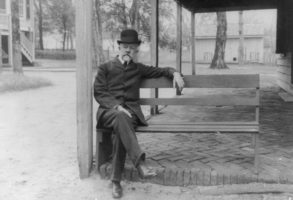
Published December 13, 2018
In every art form there has been a “battle of styles,” as the old idioms became tired and repetitious, and new idioms searched for space in the creative mêlée. For the most part the battle has been good humored, with new solutions steadily gathering approval from the art-loving public. The passage of The Rite of Spring from an act of outrageous defiance to a classic of the symphony-hall repertoire is a case in point, as is the rise of T.S. Eliot from the purveyor of arcane mysteries to the unofficial poet laureate of the modern world. Art lovers have mostly taken an open-minded attitude in this battle. They have recognized that what seems like anti-human defiance may often be a deeper form of acceptance, so that apparent ugliness might turn out to be real beauty in the long run.
There is one exception to this ecumenical approach to modern art, and that is architecture—an exception that goes to the heart of architecture’s status as an art. From its beginnings in the Bauhaus, architectural modernism has been less an aesthetic experiment than a moral crusade, typified by the polemics issuing from the Centre Internationale de l’Architecture Moderne (CIAM) in the 1920s. Those who advanced the “international” style were animated as much by revulsion towards the existing fabric of our cities as by enthusiasm for the new materials and the large-scale projects that they facilitated. They referred constantly to the benighted quality of their opponents, who were not simply competitors in the realm of style but wicked reactionaries, withholding the benefits of progress from the mass of humankind.
The modernists belonged, on the whole, to the revolutionary wing of contemporary socialism, with Hannes Meyer, as director of the Bauhaus, explicitly pledging allegiance to the Leninist vision, while others, like the endearing Karel Teige in Prague, advocating a romantic and poetic communism designed to liberate the common people without controlling them. Le Corbusier attempted to join this revolutionary movement at a certain stage but, finding a more congenial sponsor in the Vichy Government of war-time France, he moved right-wards, without, however, losing the totalitarian mentality that united him to Gropius and Meyer.
This totalitarian mentality should be seen in its historical context. Modernism came to the fore in the wake of the First World War and the Russian Revolution, when massive displacements of populations into cities ill-adapted to receive them suggested that only large-scale planning could prevent disaster. The first duty of government was to take control, and to provide for the basic social needs of people on the verge of starvation. The great housing projects of the post-war period began from that thought, and the new materials, which made it possible to build without the constraints contained in the dying tradition of post and beam construction, offered what was seen at the time as the only possible solution to a growing social problem.
This solution was the estate of high-rise apartment blocks set in a green space, which involved building on a scale that had previously been impossible, and building according to a top-down plan, rather than according to the tastes of individual house-owners. The international modernist aesthetic was, to a great extent, an effect of that way of building, rather than a cause of it. But it was presented as an aesthetic innovation, and the inspiration for the new building types. People who didn’t like it—and then as now they were the majority—were held to be committing the same kind of aesthetic crime as those who banished Manet from the salons, or those who rioted at the first performance of The Rite of Spring.
In due course an element of realism entered the contest, though not before “slum clearance” had removed much of the genial fabric of our city streets, and the high-rise estate had risen from the ruins. High-rise buildings do not, on the whole, last much longer than the illusion that people want to live in them. Within thirty years the dilapidated towers, standing in a sea of garbage, ravaged by vandalism and criminal gangs, and with many of their residents suffering from mental health problems and living in a permanent state of anxiety, are usually blown up, and their population re-housed in the next generation of mistakes, this time comparatively low-rise buildings of concrete trays, stacked beside streets on which their backs are turned: a idiom that can be encountered in its most brutal form in London’s Elephant and Castle estate, the work of the Smythsons.
At the same time, the message that the modernist idioms are uniquely suited to our age is still shouted at the top of the voice in the schools of architecture. We may have moved on from the great socialist projects; but we have not moved on from the architecture to which they gave rise. Curtain wall structures along existing streets offer a lucrative way to exploit the infrastructure of our cities, so that the financial interest in defending this style against all-comers has become one of the most important causes in the architecture journals. The schools no longer teach facades or streets or skylines, but only “envelopes.” The resulting soap-bubble architecture is disliked by almost everyone, and the architects themselves are seldom observed to live in the vicinity of what they build, preferring elegant Georgian terraces along old-fashioned streets.
Nevertheless, there remains in the background of the modernist movement a kind of fury, an indignant assault on all alternatives, and a readiness to accuse opponents of every kind of moral, political, and intellectual failing, and in particular of the “historicism” effectively criticised by Teige and others, and subsequently confused with any sincere attempt to treat architecture, as it should be treated, as an art of composition. In a recent book, Making Dystopia: The Strange Rise and Survival of Architectural Barbarism, the distinguished architectural historian James Stevens Curl goes to the root of the “international style” championed by the early modernists, and documents its long-term psychological effects, in ways that leave no doubt that the whole thing has been a mistake—a mistake motivated at first by ideology, subsequently by greed. Curl’s book is well worth reading; but so too is the response to it by the architectural establishment, with reviewers crowding each other out in the competition to cast spells against this intruder from the realm of aesthetic reaction.
The fury vented against Curl was far out-done by that vented against me, when the British Government announced that I would be chairing a commission established to review the need for beauty in new building. It was assumed that I would side with my own personal preferences against all rival styles, since after all that is what leftists do—namely, close all questions in their own favor by allowing no opposing voice.
Just about every name in the book of political correctness has been flung at me—Islamophobia, racism, homophobia, even anti-Semitism—in order to dissuade the government from my appointment. So far the campaign hasn’t worked. But it has awoken me to the fact that the fury of the modernists is no passing agitation, but part of what they are. The hatred of which I have found myself to be the target is exactly the attitude that is embodied in those featureless high-rise blocks in which the working classes were to be imprisoned. It is present too—dare I say it—in those polished aquariums where the superrich blow bubbles against the glass for a year or two like exotic fish, before suing the architect who designed their costly prison. Both templates are deeply hostile to what matters in human life, which is the ability to live side by side in privacy, to enjoy the benefits of family love, and to cooperate with one’s neighbors in creating a place that belongs to us all.
Roger Scruton is The American Conservative’s New Urbanism Fellow.








